|
The phylum Mollusca is a very large and diverse group of animals that ranges from what appear to be immensely basic creatures to the most advanced and intelligent invertebrates known. Although an octopus and an oyster appear to have very little in common, a number of features are common to all members of this phylum and unique within the animal kingdom. Molluscs are soft-bodied animals, in some cases with an internal or external shell. A number of molluscs, such as limpets, appear to have radial symmetry (though they have bilateral symmetry), and others appear to have no symmetry at all, such as many gastropods with fancy shells including Lambis chiragra or Chicoreus cornucervi; all these animals are bilaterally symmetrical during their developmental stages, and exhibit secondary changes in symmetry. All molluscs have a mantle, which is a fold of skin that lines the shell or, in those without a shell, covers the body. A muscular “foot” is common to all molluscs, although in some groups it has been reduced (e.g., bivalves) or modified (e.g., cephalopods) and, with few exceptions, it’s used for locomotion.
The phylum Mollusca contains 11 classes, three of which are extinct and four of which are of interest to aquarists. Those of interest to the aquarium trade are cephalopods, gastropods, polyplacophorans and bivalves. With over 110,000 species named, a huge number are often encountered by aquarists.
Kingdom: |
Animalia |
Phylum: |
Molusca |
Class: |
Cephalopoda* |
|
Gastropoda* |
|
Polyplacophora* |
|
Bivalvia* |
|
Scaphopoda |
|
Monoplacophora |
|
Aplacophora |
|
Caudofoveata |
|
Extant classes of molluscs
(*Those of interest to aquarists). |
Countless species of molluscs are found in marine aquaria; some are ornamental, some are functional and some are undesirable species often unknowingly added to an aquarium. These animals vary greatly, and although most are benthic, many are mobile. One group, the cephalopods, includes nektonic animals that can grow exceptionally large. Although many species are visually unappealing to most aquarists, a number of species are quite impressive and make colorful and interesting additions to aquaria, including giant clams, octopuses, nudibranchs and “flame scallops.” However, as with any species, it is important to research the requirements of any mollusc you intend to add to your aquarium because many have special dietary, behavioral or lighting requirements.
Molluscan diets vary greatly; molluscs include planktivorous herbivores, carnivorous or herbivorous grazers, scavengers or even active predators, including piscivores and crustaceovores. With the exception of bivalves, all molluscs possess a type of tooth structure called a radula, which varies between groups depending largely on the species’ diet. An entire article could be written on the structures of the various radulae found in molluscs, but it is important to note that they do vary greatly. In some groups the radula consists of many teeth, such as in octopuses, where the radula is a drill-like structure used to bore through crustaceans’ shells; or in herbivorous grazers, such as chitons or any of the various grazing snails. In other cases, the radula consists of far fewer teeth, such as in Conus spp., which have only two long teeth used as a harpoon-like implement to inject toxin and disable their prey.
Cephalopods
This group of molluscs bucks the trend when it comes to the popular belief that invertebrates, especially molluscs, are unintelligent organisms. With highly developed eyes and an impressive acquity, particularly in the case of octopuses, these animals are considered to be highly advanced creatures and, therefore, make entertaining additions to the home aquarium. While a majority of cephalopods are now extinct, most modern cephalopod species belong to orders within the subclass Coleoidea, with only a single remaining genus from the subclass Nautiloidea and no living species from the subclass Ammonoidea. Offered to aquarists, this group includes octopuses, cuttles, bobtail squid, squid and Nautilus spp. Regrettably, most cephalopods of interest to aquarists, especially smaller species, have a very short lifespan of between six months and two years. This means that unless the animal is acquired at a very young age, its longevity will be very limited in the aquarium.
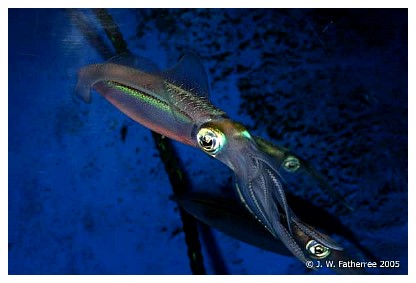 |
Although it's not evident in this photo, squid have a sharp horny beak composed mainly of chitin. Photo courtesy of James Fatherree. |
Cephalopods have a modified foot that has developed arms and/or tentacles that are used for locomotion and prey capture and have a waterjet propulsion system via an organ known as a hyponome. This is an entirely carnivorous class of molluscs, feeding largely on crustaceans and fish. Using their arms and tentacles to capture prey, the more developed cephalopods of the coleoidean subclass have developed suckers, which aid in capturing and immobilizing their prey.
Nautiluses, the most primitive of the modern cephalopods and the only extant group outside the coleoidean subclass are, fortunately, not readily available to aquarists, though at times they do appear in the trade. This group is distinguished by a spiral-shaped chambered shell, used both as protection from predation and for vertical locomotion or buoyancy. As with other cephalopods, these animals use a hyponome for waterjet propulsion, but they also can control their buoyancy using changes in the fluid content of the chambers of their shells. These animals can change the ratio of water and nitrogen gas in their shell chambers to increase or decrease their buoyancy at such a rate that they can maintain neutral buoyancy at any depth almost immediately. Nautiluses have far more tentacles than other modern cephalopods, with some species having up to 90 arranged in two circles beside their mouth. This is the only group of modern cephalopods that exhibit polycyclic reproduction, with annual reproduction. While they may have a lifespan of up to 20 years in the wild, in captivity, public aquariums have so far been able to keep them only up to five years. The female lays eggs in shallow water, attached to rocks and, depending on the species, juveniles hatch after eight to 16 months.
|
Nautiluses manifest a type of camoflauge known as countershading, i.e. when viewed from above, the darker area of its shell blends into the darkness of the water below, and when veiwed from below, the shell's lighter bottom blends into the light emanating from the surface. Photos courtesy of James Fatherree. |
The majority of coleoidean cephalopods encountered by aquarists have eight arms (Octopodiformes) and some, such as cuttles and squid, also have two additional tentacles (Decapodiformes). The tentacles of Decapodiformes generally contain a single suction cup and are used as the first contact point in prey capture. The eyes of coleoidean cephalopods are believed to be among the most developed in the animal kingdom, similar to that of vertebrate eyes as a result of convergent evolution. Their eyes, like ours and unlike the more primitive cephalopods, contain a solid lens but, unlike our eyes, are generally unable to differentiate colors, only shades. Despite this, most of these animals display phenomenal color changing abilities that allow them to match almost exactly their environment’s color. Editor’s note – musculature allows textural camouflage as well. These animals generally reproduce by the male depositing a sperm packet into the female’s mantle, after which the female lays eggs hidden under rocks or framework crevices. In some groups such as octopuses, the female guards the eggs until she eventually dies of starvation; but in all species, both parents die soon after reproducing, known as semelparity.
|
An octopus. Photo courtesy of Greg Rothschild. |
Octopuses are a group of animals that interest most aquarists due to their high level of intelligence, their ability to change shape and color and their inquisitive nature. In contrast, their short lifespan, prey capture of most other aquarium inhabitants, and their ability to escape from all but the most secure aquariums make them less than ideal additions to the majority of aquaria. If the system is planned correctly and all escape routes are secured, including lids and overflows being firmly secured, octopuses make very interesting pets and can be reasonably easy to care for. All octopuses are carnivorous, generally feeding on benthic crustaceans and, occasionally, on fish. At the Seattle Aquarium, an octopus was observed killing 3-4’ long sharks. In various situations at public aquaria and in research labs, octopuses have been known to escape from tanks, feed on crabs, shrimp or small fish in nearby aquaria and then climb back into their own tank during the night. They are known to be able to tolerate air exposure and have been taped “walking” across sand and rocks from tidepool to tidepool. Often, live food such as crabs or shrimp must be offered, but watching an octopus capture and consume live crustaceans is one of the more interesting parts of owning one of these fascinating creatures. Octopuses are generally nocturnal, emerging from their lair only to feed or scout their territory. For aquarists this means that they can, at times, be fairly uninteresting to watch. Given their intelligence and their highly flexible body which can move through gaps no wider than their beak (the only solid part of their body), octopuses have even been known to acquire food by opening screw top jars! An exception to this, is the Hawaiian Day octopus (Octopus cyanea), which is quite active during the day time. However, this species can grow to several pounds in size and is only suitable for large aquariums over 100 gallons.
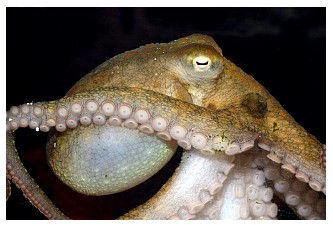 |
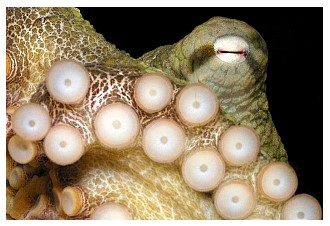 |
|
A male octopus can live only for a few months after mating; females typically die shortly after their eggs hatch. Photo courtesy of Greg Rothschild. |
As mentioned, one of the most intriguing aspects of octopuses is their ability to change color rapidly. This trait is shared with many other cephalopods, including squid and cuttles, and is a result of chromatophore cells which can alter their skin’s color. These cells contain pigment sacs surrounded by neural and muscular cells that control how the pigments or pigment combinations are displayed. As these muscle cells expand and contract, different color combinations can be created, giving the animal the ability to create camouflage, display warning colors or attract mates. It is believed that cuttles use rapid color changes as a mechanism to sidetrack prey by using flashes and waves of color before they attack. In combination with their ability to rapidly change colors is these animals' ability, best displayed in octopuses and cuttles, to change the texture of their skin for both camouflage and display. One interesting species that takes morphology and pigmentation changes to a whole new level is the mimic octopus, Thaumoctopus mimicus, which mimics a variety of marine organisms such as sea snakes, lionfish and venomous sole fish. This species uses a combination of changes in morphology, coloration and behavior to replicate the appearance of up to 15 organisms, most of which are venomous, unlike the octopus itself. This octopus has even shown the ability to select the most appropriate model species for a given situation, such as mimicking a sea snake that preys on damselfish when under attack by damselfish.
The Hapalochlaena spp. octopuses (blue-ringed) from the western and southwest Pacific are renowned for their toxic venom, which has been known to be fatal to humans. These species, possibly along with others from the genus Amphioctopus, possess symbiotic bacteria in their salivary glands. These bacteria produce toxins that the octopus uses both defensively and offensively. Hapalochlaena spp. produce a combination of two toxins, maculotoxin and hapalotoxin, with different functions. Maculotoxin, which is used largely for defense, is believed to be the same neurotoxin as tetrodotoxin, produced by bacteria in a variety of Tetraodontiformes (such as pufferfishes, porcupinefishes, boxfishes and cowfishes), in addition to many other unrelated species, and is lethal to many vertebrates, including humans. Hapalotoxin is believed to be used more often in attacks and is a neurotoxin that can disable some invertebrates such as crustaceans, their main prey. Hapalotoxin can be released into the water column, in the same manner that ink is used by other cephalopods, to slow prey from a distance before the final attack. This reduces the risk of damage when the octopus makes contact with a healthy, armored prey item.
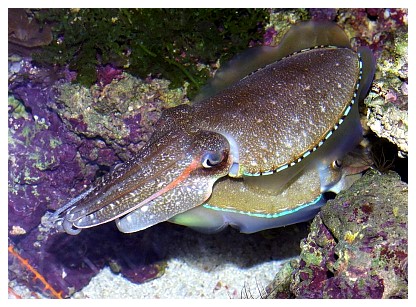 |
|
Cuttlefish are known as the "chameleon of the sea" due to their ability to rapidly alter their skin color at will. Photo courtesy of Greg Rothschild. |
Cuttlefish can make fantastic pets. Although they are short-lived like most octopuses, their intelligence is obvious and their chances of escaping from the aquarium are nil. Watching a cuttle stalk and kill a live prey item can be fascinating. The cuttle approaches slowly, using color and textural changes in its mantle to remain camouflaged. As it moves closer, it begins to flash colors with waves of pigment across its skin, known as “passing cloud.” This is believed to be a ploy to hypnotize its prey while the cuttlefish lines up for the attack, hovering above the substrate before an attack that is one of the fastest movements known in the animal kingdom. The two tentacles are fired from its body and, in a fraction of a second, the prey is caught with no time to react. There are a variety of cuttles, but only a few of the smaller species such as Sepia bandensis and Metasepia spp. (flamboyant cuttle) are suitable for captivity in the average home aquarium.
 |
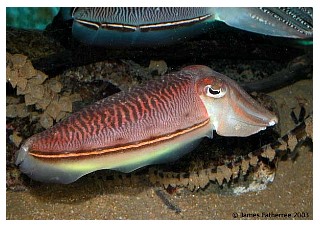 |
|
Like squid and octopuses, cuttles can produce ink if needed. Photos courtesy of James Fatherree. |
Gastropods
Gastropods are defined by a developmental phenomenon known as torsion, in which the mantle and visceral mass (the abdominal region that contains most internal organs) is rotated 180° such that the anus is located above the head. Some groups display secondary detorsion at a later developmental stage. Gastropods are also distinguished by their locomotion through the use of a muscular foot, and have either a single shell or no shell at all. In the aquarium trade these animals are of interest both for ornamental and functional purposes. The most popular among aquarists are the algae grazers, such as Trochus, Turbo and Nerites spp.snails, tropical abalone and some species of nudibranchs.
The gastropods are divided into three main groups based on their respiratory structures: the monophyletic group pulmonata and the paraphyletic groups, opisthobranchia and prosobranchia. Pulmonates are the more evolved group of gastropods that have developed a lung-like organ known as a pallial lung, due to their highly vascularized mantle cavity. These gastropods are almost exclusively terrestrial or freshwater, with only a few intertidal marine species. Opisthobranchs, or sea slugs, have external gills that are located behind their heart. All the remaining gastropods are prosobranchs, and their gills are located in front of their heart.
Known largely as sea slugs, the order Opisthobranchia contains a variety of marine gastropods including sea hares, nudibranchs and bubble snails. Most members of this group have reduced shells or no shell at all, and none can withdraw into their shell completely for protection. With few exceptions, opisthobranchs are collected for the aquarium trade due to their brilliant coloration, which attracts many aquarists. Most of the animals collected, however, are largely carnivorous and have highly specialized diets consisting of bryozoans, sponges, stony corals, soft corals or tunicates. In some cases these animals specialize in feeding on a single prey species; and in other cases, they mimic the target species to camouflage themselves to predators. An example of this is the nudibranch Phestilla melanobrachia, which feeds on coral species from the family Dendrophyllidae (e.g. Tubastraea) and has cerata (filamentous extensions of the body) to mimic this coral's tentacles. Their coloration varies between regions to mimic the local species, e.g., yellow and red coloration where Tubastraea coccinea is common. A somewhat common species of nudibranch available to aquarists is the Spanish dancer, Hexabranchus sanguineus, which is impressive not only for its bright coloration and the fact that it grows to an impressive 40cm (22”), but also because it often swims with commensal shrimp, usually Periclimenes imperator, like a red magic carpet. Like many species of nudibranchs, however, this species is next to impossible to keep in captivity due to its specialized diet, consisting of only a few species of sponges that are unlikely to be kept in constant supply by an aquarist.
Uncommon in the aquarium trade are sea hares (suborder: Anaspidea), which can be useful algae grazers but possess the ability to release a slightly toxic ink, similar to that released by octopuses and squid. These gastropods feed almost exclusively on filamentous algae and macroalgae and, therefore, pose no threat to corals or other invertebrates in aquaria. The risk of ink release in the aquarium depends on its tankmates and other conditions; the ink’s possible side effects also depend on tankmates present and the aquarium’s size. Inking is almost always a direct result of an attack from predatory fishes such as large wrasses, but may occasionally be due to other stressors such as sudden changes in water parameters (e.g., during large water changes). In a small tank the result can be catastrophic, especially if a large sea hare expels a large quantity of ink; whereas in a large tank damage can be minimal. In all cases, however, a water change should be performed immediately. A toxin is also found in the sea hare’s skin, which makes them distasteful and unappealing to predators.
|
A reef-safe cowrie. Photo courtesy of www.reefermadness.us. |
The majority of gastropods sought by aquarists are herbivorous and scavenging prosobranchs. There are, however, a few species of very interesting carnivorous prosobranchs, most notably Conus spp., which can make great inhabitants in a species tank or, occasionally, in a reef tank. Prosobranchs, as previously mentioned, are not a monophyletic group, meaning that the group does not consist solely of species with a common ancestor. This means that, although there are some common structures within the group, some prosobranchs are more closely related to opisthobranchs than they are to each other. A wide variety of prosobranchs can benefit aquarists, with many offered by retailers; but many species are also offered as grazing snails when they are actually carnivorous predators, often of other gastropods. A common feature among prosobranchs is the presence of an operculum which is a proteinaceous or calcareous covering over the shell opening that serves to protect the animal both from predators and desiccation. The operculum is attached to the dorsal side of their foot and automatically closes if the animal retracts entirely into its shell, in most cases completely sealing the opening.
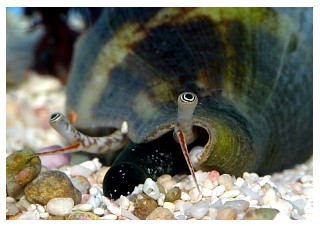 |
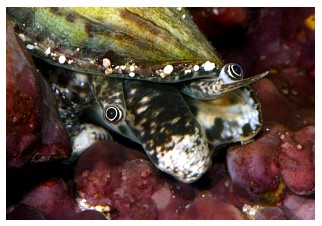 |
|
Conchs are noted for their unusual eyes at the end of their stalks. Photos courtesy of Greg Rothschild. |
Many types of snails are regularly offered to aquarists, including Trochus spp., Turbo spp., Strombus spp. and Astraea spp., to name just a few. With a huge variety available to select from, it is important to consider the specific diet and maximum adult size of most of these animals before purchasing them. Although Trochus spp. can be beneficial in the removal of Bryopsis algae, they can get large and obtrusive, making them less suited than other snails to small aquaria. On the other hand, some of the small Turbo spp., such as T. argyrostomus, are less destructive and may reproduce readily to suit any sized aquarium, leading to the production of a healthy population for controlling filamentous algae. Conches such as Strombus spp. and Lambis spp. can be useful for cleaning algae from the sandbed, and some also help to remove detritus. Cowries such as Cypraea spp. and Ovula spp. are regularly offered in the trade but, although there are a number of suitable species, the majority are either carnivorous, omnivorous or generally destructive. One common species available is the eggshell cowrie, Ovula ovum, bought by many to help rid their aquarium of algae when, in fact, they are a carnivorous snail that feeds on soft corals’ flesh. Other beneficial prosobranchs are often found on live rock, such as limpets, which are often overlooked. True limpets are generally intertidal, and this has resulted in a very dorso-ventrally flattened shell with a large, round muscular foot that fills the underside of their shell. These adaptations are due to the high energy environment they live in, as well as the harsh environmental conditions associated with the intertidal zone such as rain and large temperature fluctuations. Many limpets exhibit homing behavior, meaning that after grazing, they return to the same place on the rock where, at the drop of the tide, they clamp down tightly, sealing in moisture to avoid both desiccation, and the potential influx of freshwater if it rains. This ploy also serves to protect them from their many predators, including other gastropods.
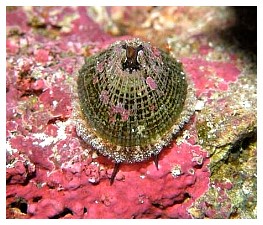 |
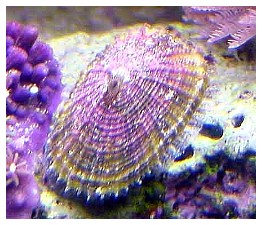 |
|
Limpets can attach to rock surfaces with very considerable force when necessary, and this ability enables them to remain safely attached, despite the dangerous wave action found on the exposed rocky shores they inhabit. Photos courtesy of James Fatherree (left) and Kip Peeler (right). |
A large group of prosobranchs, occasionally encountered by aquarists but rarely sought by them, are the carnivorous cone shells of the Conus genus. These are well-known to many aquarists due almost exclusively to the fact that the genus contains two species of lethal snails that hunt fish and possess a powerful neurotoxin similar to that found in blue-ringed and blue-lined octopuses (Hapalochlaena spp.), and a number of poisonous pufferfish and their relatives. The toxins found in this group of snails are collectively known as conotoxins and, for the most part, are harmless or, at worst, painful to humans. The majority of the over 500 species of cone shells are vermivores, some are molluscivores and, as mentioned, two species (Conus geographus and C. textilis) are piscivores. These two species may be kept in species tanks, and feedings can be quite interesting, with the snail able to ingest prey items almost as long as its own shell. As with any venomous animal, however, especially those that are potentially lethal, caution should be taken by anyone who decides to take on the care of such a pet.
One unusual group of snails encountered regularly by aquarists, but rarely recognized for what they are when first seen, are the vermetid snails. Often the first sign of these animals in an aquarium are white spider web-looking projections throughout the aquarium, often coating rocks or corals. Vermetid snails are unlike almost all other prosobranchs in that they are firmly attached to rocky substrate and feed by sending out mucous threads, which are used to pick up small zooplankton and particulate material. The juvenile form of these animals is a small snail not unlike many we are familiar with, but the initially motile snail soon cements itself to the rocky substratum and forms a calcareous tube not unlike that of a serpulid or sabellid worm, and the tube’s opening is covered by the snail’s operculum when it retracts into its “shell.”
|
Vermetid snails are easily spotted in reef aquaria by their calcareous tubes. Photos courtesy of James Fatherree. |
Although not exceedingly common in the aquarium trade, abalone from the genus Haliotis can make useful additions to large aquaria because they make excellent algae grazers. Abalone differ from other gastropods by having a line of seven respiratory holes along the outer edge of their shell. In many species the shell's inner layer is composed of nacre or mother-of-pearl (a type of aragonite structure) in such a quantity that it is sought after for jewelry. Not all abalone are suitable for aquaria since many species are subtropical or temperate. However, the donkey’s ear abalone, Haliotis asinina, is a tropical species reaching around 12cm (5”) and is a hardy, though at times clumsy, species that can make an excellent grazer in a reef aquarium.
Polyplacophorans/Chitons
Like gastropods, chitons use a muscular foot for locomotion but are differentiated by a shell consisting of eight plates, as well as a dorso-ventrally flattened body. This small group of molluscs has evolved to live in the intertidal zone and can attach firmly to rocks and seal themselves at low tide, retaining sufficient water until the tide rises again. Their eight valves (shells) allow these animals to maneuver closely around rocks, keeping themselves inconspicuous and protected from predators while reducing the effects of intertidal conditions such as wave action. Surrounding the eight shells is a layer of soft tissue coated by a thin chitinous layer, which affords almost complete protection from predators and environmental conditions such as heat and waves when the animal clamps down onto rocks. Polyplacophorans are almost exclusively herbivorous, feeding on filamentous and macroalgae at high tide and, therefore, are ideal candidates for reef aquaria. Although these beneficial grazers are rarely available for sale in the aquarium trade, they are easy to care for and are less destructive than many alternative grazers such as urchins and large snails. However, they are slow moving, and their grazing activities can scratch acrylic aquariums.
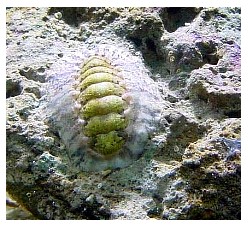 |
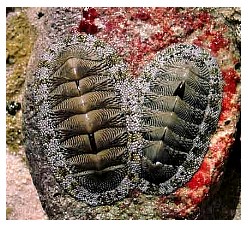 |
|
Like the limpets, chitons have a strong muscular foot that helps keep them firmly attached to rock surfaces. Photos courtesy of Gudmundur Geir (left) and James Fatherree (right). |
Bivalves
The bivalves include a large number of molluscs that are often found in aquariums attached to live rock, as well as ornamental species such as flame scallops (more correctly called file clams as they are not scallops) (Lima spp. and Limaria spp.) and giant clams (Tridacna spp. and Hippopus spp.). As their name suggests, these animals possess two valves (shells), limiting their ability to move. Some species of bivalves attach firmly to rocky substrata, and others burrow into soft substrata; the remaining few species utilize their sheer body weight to hold them down to the reef’s floor. Species that attach to rocky substrata, which are the majority of those encountered by aquarists, do so by using their byssal muscle and byssal threads, often accompanied by a boring behavior, resulting in the animal being permanently embedded into the rock. By embedding themselves in rocks, bivalves can protect their most vulnerable area, their byssal opening and adductor muscle.
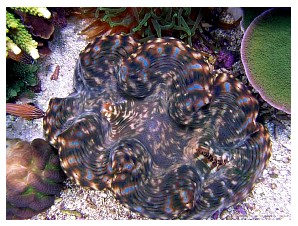 |
 |
|
Tridacna clams are well known by aquarists for their beautiful mantles when viewed from above. Photos courtesy of Aleksandr Pyndyks (left) and Andy Bajc (right). |
The main commercial interest in bivalves is in the seafood industry (many species) and the pearl industry (Pinctada spp. and others); but these animals are not uncommon inhabitants of marine aquaria, often unintentionally added with fresh live rock. Outside the two aforementioned groups, bivalves are rarely sought by aquarists, although many, once in the aquarium, are noticed, and aquarists strive to keep them alive. Due to their general inability to move around freely, bivalves are predominantly filter feeders. Almost without exception, this makes them very difficult for the average aquarist to keep because sufficient quantities of food are difficult to maintain. Feeding is done via the gills where water is taken in through their inhalant siphon, passed across their gills for phytoplankton to be filtered out, and then ejected via their exhalent siphon.
|
A flame scallop. Photo courtesy of Marc Levenson. |
Flame scallops, such as Lima hians and L. scabra, are readily available to aquarists and are collected and bought due to their interesting mantle shape, behavior and brilliant red coloration; but invariably these animals are short-lived in aquaria due to their dietary requirements. Flame scallops are one of the few groups of highly motile bivalves, moving mainly to evade predators by rapidly opening and closing their shell and swimming by propulsion, similar to a jellyfish or cephalopod. These bivalves have sticky, tentacle-like projections from their mantle, used to capture prey. If aquarists are to have any success keeping these animals long-term, a good supply of phytoplankton such as Nannochloropsis sp. must be provided, and predatory fish such as wrasses should be avoided. Even under these conditions, flame scallops tend to fare poorly in aquaria and are probably best avoided by aquarists.
In contrast, the giant clams of the family Tridacnidae are relatively easy to care for and, provided a few basic conditions are met, make excellent additions to coral reef aquaria. Even though these bivalves feed almost exclusively on phytoplankton and bacterioplankton they have evolved a symbiotic mechanism similar to zooxanthellate cnidarians, allowing them to capitalize on a greater range of nutrient sources by using sunlight Unlike zooxanthellate cnidarians, tridacnid clams have developed a vascular-type system used to transport their symbiotic dinoflagellates (Symbiodinium spp.) through their mantle’s tissue. This symbiosis allows the host to benefit from the byproducts of the algae’s photosynthesis and metabolism, such as sugars and amino acids. Tridacnid clams also take up nutrients such as nitrogenous waste (ammonia, nitrite, etc.) and phosphorous (usually in the form of phosphates), which are metabolized by their symbiotic algae. Although phosphates are used by the symbiotic algae, in high concentrations they slow the calcification process required for shell growth in much the same way that they slow calcification of skeletons in hermatypic corals. Because of the algae transport system’s structure in giant clams, the zooxanthellae are located deeper in the tissue than they are in other zooxanthellate animals and, therefore, high illumination is required. Metal halides work best to keep these animals happy and bring out their best coloration, but many aquarists have had success using T5, power compact and even normal output fluorescent lighting.
Small tridacnids such as Tridacna maxima and T. crocea are known as boring clams, not because of their lack of a sense of humor, but because of their behavior of embedding themselves in rock, often such that the top of their shell is in line with the surface of the rock, and mantle tissue lays over both. These clams are among the most sought after by aquarists because they display some of the most brilliant colors and intricate mantle patterning, possibly a result of the fact that they generally live closer to the surface than other larger clam species. The larger species, T. derasa, T. squamosa, T. gigas, Hippopus hippopus and, occasionally, H. porcellanus, are also offered to aquarists, all of which eventually live anchored to or simply resting on a sandy substrate once they reach a suitable size. At that point these larger clams discard their byssal tissue and become anchored by the weight of their shell. Although this may make them prone to attack by burrowing invertebrates in the wild, in aquaria the risk is minimal.
Conclusion
Molluscs of all shapes and sizes can make interesting or beneficial additions to many aquariums, either as focal points in a species tank or simply as members of a healthy reef population. Most aquaria contain a huge variety of living molluscs that go unnoticed by the aquarist and, in most cases, they are either beneficial or non-threatening to the health of the aquarium's community. For some, the appeal of an aggressive non-fish predator is too good to pass up, and one of the smaller cephalopods or a cone shell can make an interesting display. In reef community aquariums where the main appeal of molluscs is as grazers of undesirable algae, a variety of snails can make the life of the aquarist that much easier. Additionally, for many aquarists the allure of a giant clam can be difficult to pass up. This group of animals has something to offer most aquarists and, for the most part, they are hardy animals that can do exceedingly well in captivity.
If you have any questions
about this article, please visit my author forum
on Reef Central.
|

